FROM THE LATINO COMMUNITY IN ENGLISH AND SPANISH





GreenState Credit Union se enorgullece de proporcionar servicios financieros a aquellos miembros que tengan un ITIN (número de identificación personal). Nos dirigimos a todos los miembros de la misma manera: Creando un valor duradero al combinar adecuadamente productos y servicios para ayudar a garantizar el futuro financiero de todos nuestros miembros. Todos los miembros de la credit union tienen acceso a las mismas tasas bajas de interés, independientemente de si abren una cuenta con un número de seguro social o ITIN.
Tipos aceptables de identificación
Para las personas que no sean ciudadanos estadounidenses, una o más de las siguientes:
• Pasaporte
• Tarjeta de residencia permanente (Green Card)
• Cualquier otro documento expedido por un gobierno que acredite la nacionalidad o la residencia y tenga una fotografía
• Ejemplos de documentos personales de identificación (DPI) aceptables:
• Una matrícula consular para ciudadanos mexicanos
• Un DUI (documento único de identidad) para ciudadanos salvadoreños
• Un DPI (documento personal de identificación) para ciudadanos guatemaltecos
Para más información, visite es.GreenState.org/ITIN
Si tiene un ITIN, GreenState puede satisfacer todas sus necesidades financieras, incluyendo:
GreenState es una credit union acreditada por Juntos Avanzamos. Este prestigioso premio nacional es otorgado por Inclusiv. Esta designación es otorgada a las credit unions que están comprometidas a servir a las comunidades latina e inmigrante proporcionando educación y servicios que promueven el bienestar.

Cuentas de cheques Cuentas de ahorros Tarjetas de crédito Préstamos vehiculares Hipotecas
Préstamos personales Consolidación de deuda Préstamos para la cuidadanía
Es viernes por la tarde, a finales de octubre, y Perlla Deluca camina por un silencioso y solitario pasillo de un antiguo edificio escolar del sureste de Des Moines.
La voz bulliciosa de Deluca y el tintineo de sus tacones altos son los únicos signos de vida en el interior de la Escuela Primaria Percy Hoak, una propiedad de unos 18,000 metros cuadrados que lleva vacía casi una década y que en su día se pensó que podría ser un lugar para construir viviendas asequibles para personas mayores. Las uñas rosas y el sueter de cuello alto de Deluca destacan sobre su atuendo negro y las paredes vacías del edificio.
Como una artista dispuesta a presentar un nuevo proyecto, Deluca, empresaria y propietaria de la empresa contratista Southeast Constructors, con sede en Des Moines, afirma que su visión de este espacio es sencilla: Quiere crear una escuela integradora para dotar a la próxima generación de jóvenes -especialmente mujeres- de los conocimientos necesarios para trabajar en la construcción.
Deluca ha sido elegida por el Des Moines Register como una de las 15 personas a tener en cuenta en 2023 porque, el año que viene, ella y su equipo tienen previsto reabrir la antigua escuela primaria del 1801 de la avenida McKinley con un nuevo nombre, Iowa School of Construction, y dar la bienvenida a su primer grupo de estudiantes.

Los alumnos, 20 de los cuales ya se han inscrito, seguirán un curso de 12 semanas que incluye lecciones sobre los fundamentos de la carpintería, la soldadura, la albañilería, las herramientas eléctricas y otra maquinaria. Las inscripciones están abiertas y las clases comenzarán en febrero.
“Si alguna vez has pensado en construir algo, en crear algo, si alguna vez has pensado en comprar una casa o en dedicarte a la venta de casas, o si quieres trabajar para la ciudad, para el gobierno o en algo relacionado con la construcción, yo diría que ésta es tu oportunidad de familiarizarte con ello”, dijo. La colegiatura de la escuela, que recibió $50,000 de Iowa Workforce Development en 2022, es de $4,200 por el curso de tres meses.

Y dado que los latinos constituyen al menos el 30% de la mano de obra de industria de la construcción, la escuela planea ofrecer clases en idiomas distintos del inglés para ayudar a los estudiantes que aún están aprendiendo el idioma. Deluca, que emigró de Brasil a Estados Unidos hace dos décadas, se encargará de traducir los cursos al español y al portugués.
“Gente como Perlla, haciendo la escuela que está haciendo y ofreciendo diferentes idiomas... está eliminando barreras”, dijo Brandon
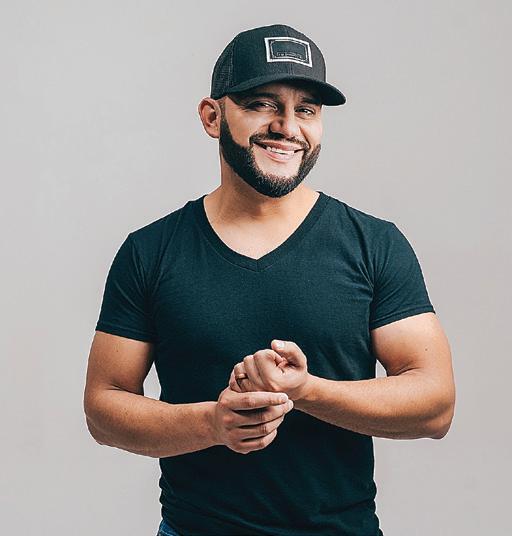
Patterson, que trabaja para la Asociación de Constructores de Viviendas de Des Moines para aumentar el número de trabajadores en el sector.

El sector de la construcción lucha por encontrar suficientes trabajadores
Deluca explicó que la idea de la escuela de la construcción surgió de lo que ella consideraba una necesidad acuciante en su sector. Aunque la pandemia de COVID-19 agravó la escasez de mano de Continúa en la página 15
Perlla Deluca, empresaria y propietaria de la empresa contratista Southeast Constructors.



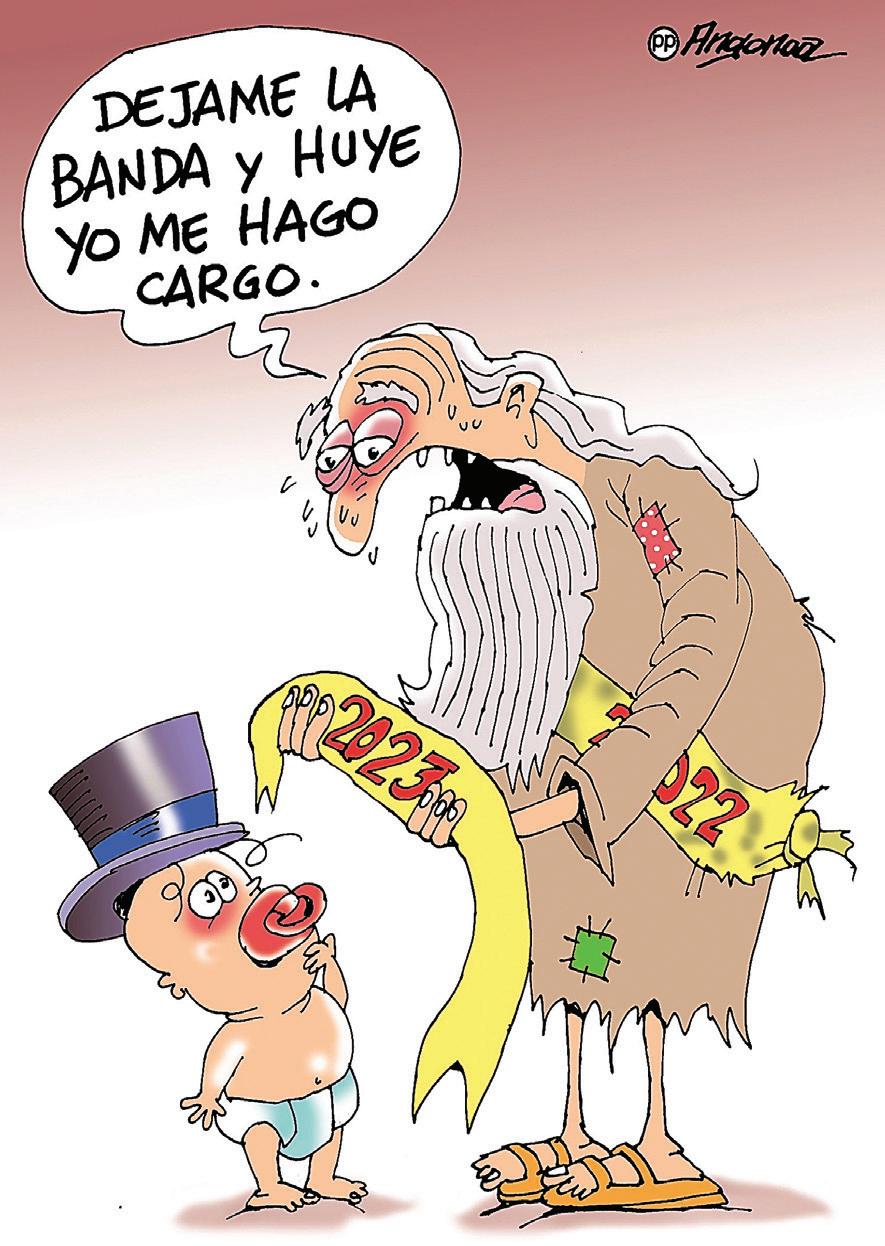
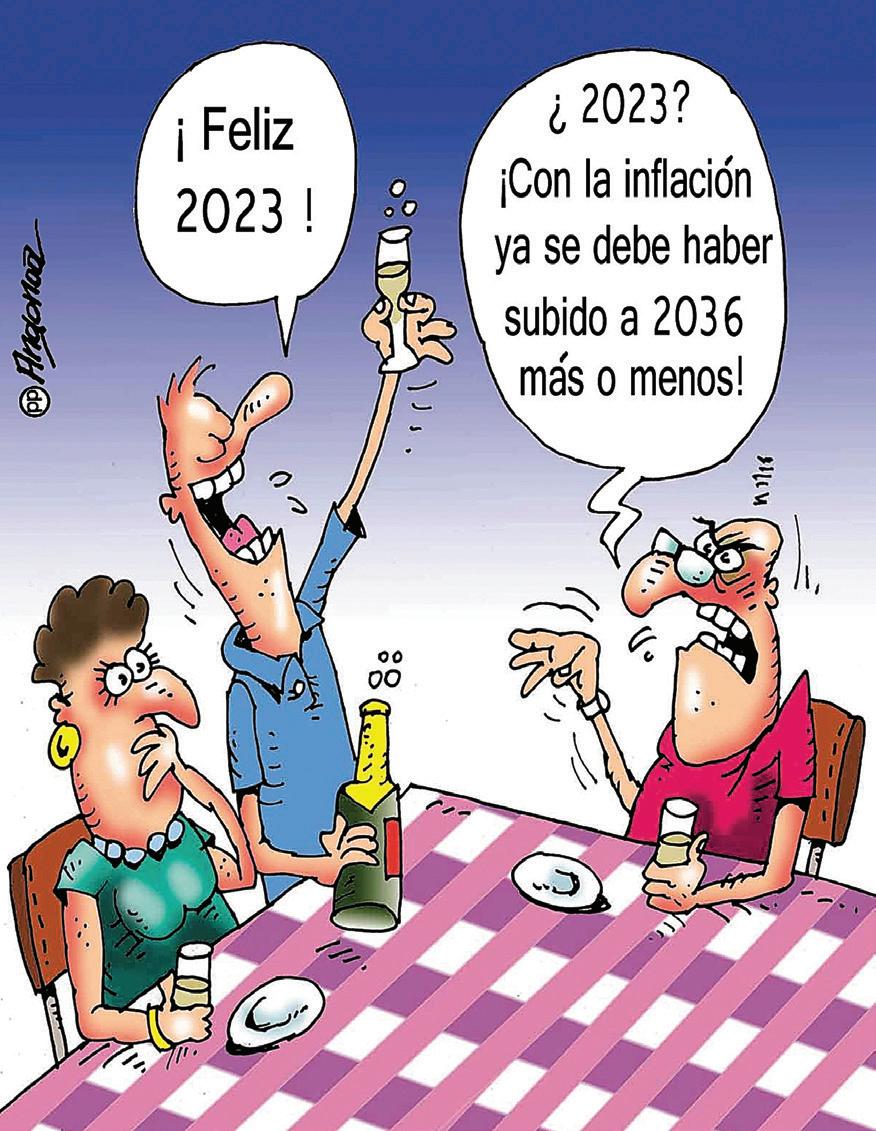

Un viajero abandonó a una perrita de 1 año afuera del Aeropuerto Internacional de Des Moines, dijo la Liga de Rescate de Animales de Iowa (ARL).
Los oficiales de servicios para animales de ARL que respondieron a una llamada sobre un perro amarrado afuera del aeropuerto dijeron el jueves que los empleados de la aerolínea les dijeron que el dueño del perro no había podido llevar al animal a bordo de un vuelo a través del país porque no tenía una caseta de perros para ella.

Dijeron que el dueño salió del aeropuerto con la perrita, luego regresó solo y abordó el vuelo de Allegiant. La perrita fue encontrada más tarde atada fuera del aeropuerto. El personal de ARL describió a la perra como “increíblemente dulce” y la llaman Allie. Notificaron a la policía de Des Moines y están cuidando a la perrita, dijo la ARL. No estaba claro el viernes si sería dada en adopción.
“El incidente sigue siendo una investigación activa, y se darán a conocer más detalles a medida que puedan compartirse”, dijo la ARL en un comunicado de prensa.

A traveler abandoned a 1-year-old dog outside the Des Moines International Airport, the Animal Rescue League of Iowa said.
ARL animal services officers who responded to a call about a dog tied up outside the airport Thursday said airline employees told them the dog’s owner had been unable to bring the animal aboard a cross-country flight because the owner did not have a kennel for her.
They said the owner left the airport with the dog, then returned alone and went on to board the Allegiant flight. The dog was later found tied up outside the airport.
ARL staff described the dog as “incredibly sweet” and are calling her Allie. They notified Des Moines police and are caring for the dog, the ARL said. It was unclear Friday whether she would be put up for adoption.

“The incident is still an active investigation, and more details will be released as they are able to be shared,” the ARL said in a news release.

ARL staff described the dog as “incredibly sweet” and are calling her Allie

Escucha Mi Voz Iowa es el primer grupo en todo el país para poner en marcha el programa federal de $700 millones del USDA
West Liberty, IA - Tras dos meses de elaboración de listas y análisis de elegibilidad, Escucha Mi Voz Iowa se convirtió ayer en la primera organización de todo el país en empezar a repartir cheques de ayuda por valor de 600 dólares a trabajadores agrícolas y de plantas empacadoras de carne como parte del programa de Ayuda a Trabajadores Agrícolas y Alimentarios del Departamento de Agricultura de los Estados Unidos.
El lunes 2 de enero, el grupo entregó más de 150,000 dólares en pagos directos en efectivo a más de 300 trabajadores agrícolas y del sector alimentario congoleños, birmanos e hispanos. El estímulo económico empezará a fluir en cuanto los bancos abran esta mañana tras las vacaciones de Año Nuevo.
Los miembros de Escucha Mi Voz afirman que seguirán repartiendo los cheques de 600 dólares a más de mil personas a lo largo de esta semana en Iowa City, West Liberty y Columbus Junction.

Al mismo tiempo, ayer, los miembros de Escucha Mi Voz en West Liberty comenzaron a procesar el nuevo programa de alivio de gastos de servicios públicos financiado por el Plan de Rescate Americano de la ciudad, donde los residentes que cumplan con los requisitos pueden recibir un crédito de
$400 a sus facturas de electricidad, agua o Internet. El programa fue diseñado y aprobado por el consejo de la ciudad de West Liberty a finales del año pasado después de que los trabajadores excluidos pasaran más de un año defendiendo y hablando en favor de los pagos directos en efectivo.
“Setenta y seis solicitaron ayer en West Liberty la ayuda para los servicios públicos”, confirmó el padre Guillermo Treviño, Jr. Las clínicas de solicitud de asistencia para pagos de servicios públicos en la iglesia St. Joseph’s continuarán esta noche, jueves y viernes de 5-9 pm en el centro comunitario de la parroquia.
El programa de 700 millones de dólares de Ayuda a los Trabajadores Agrícolas y Alimentarios fue contratado por el USDA a un puñado de organizaciones nacionales como la Unión de Trabajadores Agrícolas, la Unión Internacional de Trabajadores de la Alimentación y el Comercio (UFCW), y Caridades Católicas de EE.UU..
Catholic Charities USA recibió casi 10 millones de dólares para administrar el programa, y sub-concedió a Escucha Mi Voz Iowa 1.357 millones de dólares para identificar y distribuir ayuda a 1,800 trabajadores con derecho a recibirla en plantas no sindicalizadas de Columbus Junction, West Liberty, y a trabajadores agrícolas del condado de Washington.
Los trabajadores agrícolas y de alimentos elegibles que trabajaron al menos un día desde el 27 de enero de 2020 en una industria calificada pueden solicitar un pago directo en efectivo de $ 600.
Felicitaciones a Leticia, propietaria de Tax Lady, y Angela por el lanzamiento de su nuevo negocio Golden Union Professional Services, en Clive, IA. Estarán brindando servicios profesionales bilingües para preparación de impuestos, formación de empresas, teneduría de libros, reparaciones de crédito y traducciones, entre todos los demás servicios. Están ubicados en 8450 Hickman Rd, Suite 2 en Clive, IA. y puede hacer una cita al 515-393-8141.
#ApoyemosEmpresasLatinas
Congratulations to Leticia, owner of the Tax Lady, and Angela on the launch of their new business Golden Union Professional Services, in Clive, IA. They will be providing bilingual professional services for Tax Preparation, Business Formation, Bookkeeping, Credit Repairs, and translations, among all other services. They are located at 8450 Hickman Rd, Suite 2 in Clive, IA. and you can make an appointment at 515-393-8141.

#SupportLatinaOwnedBusinesses
Euphoria Cakes now has a storefront and it is at Echo’s Cookies in Waukee, IA.

Their address is 272 Hickman Rd, Waukee, IA 50263.
If you need a beautiful cake or goodies for your next special event Euphoria Cakes are amazing. Their number is 515-421-0413. Congratulations Carolina!
#SupportLatinaOwnedBusinesses


Davenport, IA - Ya estamos en año nuevo, pero el Museo de Arte Figge ya tiene la vista puesta en un nuevo año más brillante: 2025, que espera ser trascendental en muchos sentidos.
Este emblemático museo del centro de Davenport no sólo tiene previsto celebrar el vigésimo aniversario de su elegante edificio de cristal (inaugurado el 6 de agosto de 2005) y el centenario de la Galería Municipal de Arte de Davenport original.
A principios de 2025, el Figge (225 W. 2nd St.), de cuatro pisos, espera tener terminado su proyecto de iluminación LED de 4 millones de dólares, previsto desde hace tiempo, como parte del ambicioso Main Street Landing, a lo largo del paseo a orillas del río en Davenport.

“Sería una forma maravillosa de celebrar el centenario”, declaró recientemente Patrick Downing, director de desarrollo del Figge.
El nuevo proyecto financiado por el Estado, “Evanescent Field”, es obra del artista de iluminación de fama internacional Leo Villareal. Villareal es conocido por sus instalaciones de iluminación para distintos lugares, como el puente de la bahía de San Francisco, The Bay Lights; Illuminated River, una obra de arte pública que une 9 puentes londinenses en una sola obra; Multiverse, una instalación en un túnel de la Galería Nacional de Arte; y muchas más.
Villareal utiliza código binario y estructuras sencillas para crear complejas secuencias de luz a través de un software personalizado que incorpora el entorno de un lugar, creando una “hoguera digital” en torno a la cual la gente puede reunirse para vivir el arte. Iluminar el Figge es un

sueño electrizante que lleva 20 años gestándose.
Cuando el arquitecto británico Sir David Chipperfield diseñó el edificio actual del museo, la intención original tanto del arquitecto como de la comunidad de QC era iluminar su fachada de cristal para proporcionar un resplandor etéreo por la noche, dijo recientemente la directora ejecutiva Michelle Hargrave.
Los costos excesivos durante la construcción impidieron que esto sucediera, pero con los años surgió la idea de ir más allá de la iluminación convencional del edificio para transformar el Figge a través de la luz y el arte, convirtiéndolo en una obra de arte pública que toda la comunidad pueda disfrutar.
La idea de convertirlo en una obra de arte Continúa en la página siguiente


transformadora e inolvidable (que diera nueva vida al horizonte de Davenport) surgió en torno a 2015, después de que el Figge realizara algunos grupos de discusión con la comunidad.
“La gente dijo que lamentaba que no avanzáramos con la iluminación del edificio”, dijo Hargrave (que lleva tres años en el puesto). “El Figge es una joya durante el día, pero por la noche se queda a oscuras. Toda la manzana está a oscuras”.
El anterior director, Tim Schiffer, dijo que en lugar de limitarse a iluminar el edificio desde el exterior, querían hacer una manifestación más grande e iluminarlo desde dentro, dijo Hargrave, señalando que contrataron a Villareal en 2015.
El diseñador de iluminación visitó el Figge ese año, experimentando con diferentes colores.
A través del museo, Villareal dijo recientemente: “Me siento honrado y emocionado por la invitación a crear una obra de arte pública llamada Evanescent Field en el Figge Art Museum. Esta escultura lumínica se integrará en la impresionante arquitectura de David Chipperfield con el objetivo de activar el museo mediante secuencias de luz ondulante para disfrute de todos los habitantes de los Quad Cities.”
dijo Chipperfield: “Estoy encantado de saber que el plan original de iluminar la fachada se hará finalmente realidad y espero ver personalmente el proyecto realizado lo antes posible”.
Villareal hizo un concepto básico de diseño hace años, pero el museo no tenía dinero para lo que sería un plan de 4 millones de dólares, dijo Hargrave. Schiffer solicitó sin éxito una ayuda del Fondo Nacional de las Artes y, cuando Hargrave empezó, se lo mencionaron desde el principio como un proyecto prioritario.
“Sería realmente genial iluminar el edificio”, dijo. A principios de 2020, se reunieron con David Raver, de RDG Lighting, en Des Moines, para hablar del proyecto.

Habrá 3,000 pies de tiras de LED colocadas a través del museo, y accesorios que pueden soportar temperaturas de 150 grados, dijo Hargrave. En total se colocarán 1,100 luces LED entre las dos paredes, y un servidor controlará la programación de las luces, determinando la secuencia de los patrones.
Puede producir hasta dos millones de colores, explica Hargrave. “La tecnología ha avanzado tanto que las propias luces pueden lograr todos estos colores diferentes”, dijo. “También es la programación que Leo ha puesto en marcha lo que ayudará a conseguir los dos millones de colores”.
Villareal nos visitará un par de veces, y para la secuenciación principal estará aquí unas tres semanas, observando el entorno, incluidos el río y el cielo, explicó Hargrave. “Así que la secuenciación en sí va a ser específica del lugar”, dijo. “Cambiará constantemente, pero estará preestablecida”.
Parte de los planes de la ciudad con Main Street Landing es mejorar el Skybridge y actualizar la iluminación para complementar lo que sucederá con el Figge. El Skybridge tiene paneles de cristal de colores similares a los del museo.
El Skybridge, de 7 millones de dólares, también se inauguró en 2005, como parte de River Renaissance. Los contribuyentes de Iowa aportaron 3.5 millones de dólares en forma de subvención Vision Iowa, el casino Rhythm City pagó 2 millones y el ayuntamiento de Davenport gastó 500,000 dólares en su construcción inicial.
El Figge nació como Galería Municipal de Arte de Davenport en 1925, con la aprobación de una ley que permitía a la ciudad aceptar un regalo de 330 obras de arte de un antiguo alcalde, Charles A. Ficke, y abrir un museo (el primer museo de arte de propiedad municipal de Iowa).
En 1987 pasó a llamarse Museo de Arte de Davenport. Siguió siendo un museo municipal hasta la inauguración de su nuevo edificio de 47 millones de dólares en 2005, que recibió su nombre en honor a una importante donación de la Fundación V.O. y Elizabeth Kahl Figge.
En ese momento, la ciudad transfirió la responsabilidad de la gestión, el cuidado y la exposición de su colección al Museo de Arte Figge, una organización sin fines de lucro.
La colección original de Ficke de arte virreinal europeo, americano y español ha crecido gracias a los esfuerzos de generaciones de filántropos y líderes cívicos y ahora incluye el Archivo Grant Wood y obras de otros artistas regionalistas americanos, una extensa colección de arte haitiano y obras contemporáneas.
Es importante que Villareal es de ascendencia mexicano-americana, ya que el Figge apoya que se dé más visibilidad a los artistas de color.
“La gente de color está infrarrepresentada en los campos STEM, y esta es una oportunidad para que él trabaje con estudiantes y les inspire a pensar en esto como una posible carrera”, dijo Hargrave.
El museo ha recaudado más de 120,000 dólares para su Fondo de Diversidad y Equidad Artísticas, que está en marcha.
“Es una iniciativa importante”, afirmó. “Nos hemos comprometido a ampliar nuestra colección de arte para que sea más representativa de nuestra comunidad. Esperamos que la gente siga donando a ese fondo”.
La adquisición de arte del Figge en el último año fiscal provino toda de artistas de color o comunidades subrepresentadas, dijo Hargrave.
El nuevo fondo (puesto en marcha en 2021) tenía como objetivo ampliar la colección del museo de arte de artistas africoamericanos, artistas de ascendencia africana, nativa americana, hispana, latina, asiática, de las islas del Pacífico, indígena y de Oriente Medio, así como obras de mujeres, LGBTQA+ y cualquier otro artista que se identifique como marginado, oprimido o infrarrepresentado en la colección permanente del museo.
Activadas al anochecer, las luces de 2025 iluminarán brillantemente el emblemático edificio de vidrio del Figge, realzando el paseo fluvial al ofrecer oportunidades culturales, educativas, recreativas y de creación de comunidad a los residentes y aumentar el turismo en la región.
Aunque no se cambiará para que coincida con las fiestas
(como el puente de la I-74, que se ha iluminado de verde y rojo por Navidad), la innovadora escultura de luz de Villareal, que cambia constantemente, iluminará los cuatro lados del edificio.
Para ver más obras arquitectónicas de Villareal, visite su sitio web. http://villareal.net/


En octubre, Rubén Vázquez comenzó a desempeñar su nuevo cargo como Director de Diversidad, Equidad e Inclusión de United Way of Central Iowa. Vázquez trasladó a su familia desde las Twin Cities para convertirse en la primera persona contratada para centrarse en la equidad y la inclusión de la agencia. Durante los últimos veinte años, Vázquez ha dedicado su carrera a la justicia social, la defensa y los puestos centrados en la comunidad. Su pasión proviene de su propia experiencia. Originario de México, Vázquez conoce de primera mano lo aterrador y difícil que es vivir como extranjero y lo ha utilizado como estímulo para su carrera. Vázquez no ve la diversidad, la equidad y la inclusión (DEI) como una moda, sino como un movimiento para personas que, como él, han sufrido discriminación por cosas que no pueden evitar, como un

acento, una piel morena o un lugar de nacimiento en el extranjero.

El objetivo de su nuevo cargo es fomentar la unidad en Des Moines, especialmente entre la comunidad latina, que va camino de convertirse en el mayor grupo étnico de Iowa en 2035. “Cuanto más crece la comunidad, más difícil nos resulta vernos como un todo. Si pudiéramos ser más un ‘nosotros’, podríamos ser mucho más poderosos de lo que somos. Piensen en el poder social y político que podríamos tener si trabajáramos como un nosotros”. Cita la limitación de recursos para las poblaciones vulnerables como causa clave de la competencia entre las agencias que prestan servicios a los latinos y espera que su enfoque en la equidad dentro de los programas de United Way of Central Iowa pueda combatir la mentalidad de “quítate tú para ponerme yo” que vio en Minneapolis. Su idea es enfocar el plan estratégico de United to Thrive con iniciativas de
equidad internas y externas que creen colaboraciones mutuamente beneficiosas que unifiquen a las agencias para ayudarlas a alcanzar su máximo potencial de impacto. El plan estratégico de United to Thrive se centra en cinco elementos identificados a partir de una evaluación de necesidades realizada por United Way of Central Iowa que incluye las necesidades esenciales, el éxito en la infancia temprana, el éxito educativo, las oportunidades económicas y la salud y el bienestar. Vázquez quiere integrar indicadores clave de éxito en cada elemento centrado en la equidad. Considera que su trabajo consiste en ser la persona que cuestione la labor que está realizando United Way para garantizar que no se pierda de vista cómo las desigualdades dentro de los sistemas existentes suponen barreras para las comunidades marginadas. En otras pa-
labras, considera que es su deber liderar el esfuerzo por crear oportunidades y cambios que permitan a las personas históricamente excluidas acceder a los recursos que necesitan. “No queremos un trozo del pastel, queremos ser parte de todo el pastel”.




El planteamiento de Vázquez es de colaboración con sus colegas de United Way. Actualmente, se encuentra en lo que él llama un “Listening Tour” para hablar con cada miembro del personal y obtener sus pensamientos acerca de lo que piensan que está funcionando y donde la agencia necesita más trabajo en torno a cuestiones DEI que son eficaces dentro de la agencia, así como a sus electores. “La gente está entusiasmada con mi incorporación para hacer este trabajo, pero también están nerviosos y asustados de hacerlo porque pueden ver partes de sí mismos que no les gusten”. Sabe que debe actuar con cautela y estrategia cuando presiona a sus compañeros para que salgan de su zona de confort y se impliquen en la labor de crear equidad, pero con cuidado de no presionarlos tanto que no estén dispuestos a formar parte de los cambios necesarios que requieren el talento y la perspectiva de todos. Está preparado para el reto de liderar a United Way ha asumir un papel activo en el cambio de los sistemas en nombre de la equidad y la inclusión. Desde que se incorporó a la agencia, lo que más le ha
impresionado a Vázquez es la atención que prestan a los detalles, sobre todo cuando se dirigen a él. Es el primer lugar en el que ha trabajado que se ha tomado la molestia de deletrear correctamente su nombre, utilizando los acentos adecuados en su nombre y apellido. “Eso me dijo que me valoran como persona”. Le dijeron que era intencional y para Vázquez eso demostró que la agencia está dispuesta a poner el trabajo para hacer bien la DEI porque entienden lo importante que es. Quiere que la gente sepa que United Way está haciendo un gran trabajo para la comunidad. “Puede que no se vea como la comunidad quiere que se vea y puede que no se esté moviendo tan rápido como la comunidad quiere que se mueva, pero estamos haciendo un gran trabajo para la comunidad en general”. Vázquez advierte que, para alcanzar sus objetivos de impacto, él no es el único que debe centrarse en la DEI de la agencia. Para que United to Thrive alcance las metas de éxito dentro de la campaña, todos tienen que trabajar juntos centrándose en asegurarse de que todas las iniciativas abordan las lagunas en la equidad y el acceso para todos. “No soy un experto en DEI. Soy experto en mi propia experiencia vivida. Aporto mi experiencia vivida a mi trabajo, pero hay tantas cosas que aún tengo que aprender”. Se ha comprometido a hacer que la diversidad, la equidad y la inclusión formen parte del funcionamiento de United
Way y comprende que, al ser el primero en asumir la tarea, aprenderá junto a sus compañeros. “No pasa nada si digo que no lo sé; vamos a averiguarlo”. Espera que, con su ayuda, las prácticas empresariales centradas en la DEI se conviertan en algo más grande y sostenible. “No es una moda; es algo importante”.
Cuando se le preguntó qué significan para él la diversidad, la equidad y la inclusión, recordó las veces que fue seguido mientras compraba en Target; las veces que le pidieron la green card cuando le pararon por una infracción de tráfico en lugar de pedirle la licencia; y cómo se negaron a atender a su madre porque no hablaba inglés. Cuando se hizo ciudadano, llegó a pedir una tarjeta de pasaporte que lleva junto a su licencia para mostrarla siempre que le preguntan por su situación migratoria. Aunque esos incidentes fueron dolorosos, exasperantes e injustos, son la razón por la que está tan dedicado a asegurarse de que la inclusión, la comprensión y la equidad estén en el primer plano de su trabajo. “Llevo cuarenta y tres años viviendo en este país. En México sólo viví diez. Pertenezco a aquí”. Pero sabe que no puede hacerlo solo. “Para que nuestra comunidad tenga éxito, tenemos que comprometernos en este trabajo porque sólo puede lograrse si lo hacemos todos juntos. Va a hacer falta un sentido más amplio de comunidad para conseguirlo”.
El 12 de noviembre perdí un combate contra mi antiguo pareja de equipo, Kevin Gutiérrez, que lucha bajo el colorido nombre de “Corn Boi”. Fue un combate clásico de Lucha Libre. Yo me jugaba la máscara y Kevin se cortaría su larga cabellera si perdía. Como dicen en México, máscara contra cabellera.
Teníamos muchas líneas argumentales probadas a nuestro favor. Profesor contra alumno. Viejos amigos y compañeros que ahora luchaban furiosamente entre sí. Un luchador veterano, amargado y cascarrabias -ese soy yo- frustrado con esta nueva generación que toma cosas más a la ligera. Era una buena historia. Mientras tanto, sabía cómo acabaría: perdiendo mi máscara y anunciando mi retiro de la lucha libre. Lucharé uno o dos combates de despedida el próximo verano, pero en esencia, he terminado.
Cuando me puse la máscara a los 40 años, recordé una frase del gran periodista de lucha libre Dave Meltzer. Escribió el obituario de Junkyard Dog, el luchador afroamericano que fue una estrella estelar y ganó mucho dinero en el área de Nueva Orleans y, más tarde, en la World Wrestling Federation. “Si hubiera mantenido su peso bajo con-

trol y hubiera seguido entrenando, podría haber sido una estrella hasta los 50 años como Ric Flair, The Crusher o Dick the Bruiser”.
Ahí mismo, Meltzer me había dado la fórmula para la longevidad en este deporte.
Ric Flair también dijo en su podcast que el enemigo de cualquier luchador profesional era la inactividad. Por lo tanto, durante los últimos nueve años, he tratado de mantener un horario regular de lucha libre. Si no tenía un combate, me dirigía a la escuela de lucha Black & Brave, en Davenport (Iowa), y entrenaba en ese duro ring.
Todo ayudó. De hecho, mi trabajo mejoró al tener acceso regular a un ring por primera vez en mi carrera. Mi cuerpo se sentía bien. Eliminé los grandes pesos de mi entrenamiento, sobre todo los ejercicios que me forzaban la zona lumbar.
Mantuve mi peso bajo control. Con 1.70 m de estatura, nunca me permití superar las 230 libras, ni siquiera durante las vacaciones. La mayor parte del tiempo, la báscula marcaba alrededor de 215, y de vez en cuando llegaba a 208 libras. Con mi bronceado y mi dedicación al gimnasio, me veía bien.
Kevin y yo trabajábamos duro en la escuela. Insistí en
que entrenáramos como si actuáramos ante una multitud. Era estimulante poder trabajar por fin en mi oficio como nunca lo había hecho.
Cuando era joven, no estaba dispuesto a trasladarme a lugares que me hubieran dado la oportunidad de subir al ring y entrenar con otros profesionales. Estar en condiciones de trabajar con Kevin era una oportunidad que no podía dejar pasar. Incluso a los 48 años.
Después de varios combates largos de entrenamiento el verano pasado, pude sentir las repercusiones. Me dolía la cabeza. Cuando fui a la escuela de lucha en 1994, nos concentrábamos mucho en nuestro cuerpo. El cuello, la espalda, los hombros y las rodillas eran las lesiones que más nos preocupaban. Esos eran los peligros que nos preocupaban.
Pero nuestras mentes -nuestros cerebros- no eran una preocupación. Ahora, se estaba convirtiendo en una para mí. La ciencia de las conmociones cerebrales y la encefalopatía traumática crónica, una enfermedad cerebral progresiva, son hoy bien conocidas y preocupantes.
El aspecto físico del deporte también me hizo saber que, aunque podía soportar tanto los rigores del entrenamiento como a mis jóvenes contemporáneos, mi recuperación era más lenta. Tardaba días o una semana en recuperarme completamente de un combate de entrenamiento de 15 minutos.
Lo más desgarrador fue ver tan claramente a mi avanzada edad algo en lo que nunca había pensado a los 20 años. Yo tenía talento. Algunos de los chicos que se graduaban en el intenso programa de entrenamiento de tres meses de la escuela no tenían la misma aptitud para la vida de un luchador.

Yo era un atleta. Otros no se movían con la misma naturalidad en el cuadrilátero. Vi a innumerables jóvenes darle duro a las pesas y aun así no tener un aspecto tan impresionante, teniendo en cuenta el tiempo que dedicaban.
Mi cuerpo siempre había respondido al entrenamiento. Me encantaba levantar pesas, algo que algunos luchadores consideraban más bien una obligación. Levantar pesas consolidó lo que había estado sintiendo desde que cumplí 40 años. La lucha era mi vocación.
Lo había perseguido, sí. Pero nunca le había dedicado el tiempo, el sudor y la dedicación que exigía el oficio. Siempre estaba negociando el compromiso. A punto de cumplir 50 años el próximo mes de marzo, el Padre Tiempo me decía que estaba sobrepasando los límites.
No importaba cuánto tiempo o con qué constancia entrenara: el final estaba cerca. Sobre todo si quería escribir mi último capítulo, en lugar de que lo decidieran por mí. A medida que envejecemos, empezamos a sentirnos más vulnerables físicamente. Dudamos si subirnos a un techo o a una escalera. Todo porque ves o experimentas de primera mano los peligros físicos que presenta la vida. Pierdes la sensación de invencibilidad de tu juventud, la dichosa ig-
Continúa en la página siguiente

norancia que tenías a los 20 años.

Cuando subía a lo alto de la cuerda del ring para realizar un movimiento emocionante, mi equilibrio ya no era el de antes. Sin embargo, siempre era más consciente del riesgo que corría.
Perseguir tu pasión, frente a seguir el camino seguro, es algo con lo que la gente lleva enfrentándose muchos siglos. El editor de HumbleDollar me dio este gran consejo hace un tiempo: “Yo recomendaría ganar y ahorrar a partir de los 20, para poder dedicarnos a nuestras pasiones a los 50, cuando probablemente tengamos una idea más clara de lo que es importante para nosotros”.

Es un buen consejo si tus talentos y aficiones son intelectuales. Pero, ¿y si tienen un componente físico importante? Ojalá pudiera jubilarme a los 55 años de la planta química en la que trabajo y lanzarme a la aventura de hacer combates de lucha libre por todo el país. Pero para mi sueño, eso no es una opción. Como dijo una vez Warren Buffett: “Es un poco como guardar el sexo para la vejez”. Mi pasión tenía una ventana de oportunidad limitada, y ya pasó hace mucho tiempo.



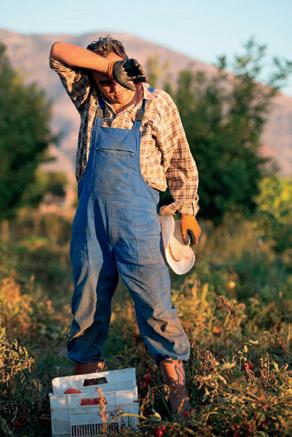

Después del combate, mis hijos y yo nos dirigimos a Applebee’s para cenar hasta tarde. Les dije que éste sería un aspecto del negocio que echaría de menos. Mi cartera estaba llena por la generosa paga. Atrajimos a mucho público y el promotor me pagó bien (300 dólares), además de que mi hija vendió muchos productos. Volví a casa con más de 600 dólares en el bolsillo. El combate fue bueno. Cumplí en el ring. Para los aficionados, para la empresa promotora, para Kevin. Mis hijos y yo sonreíamos y disfrutábamos de la comida y del brillo de la noche. Se acercaba la me-
dianoche y ya había pasado mi hora de acostarme. Pero sabía que la euforia de la noche me mantendría despierto hasta tarde.
Unos días después del espectáculo, Kevin y yo pudimos hablar por teléfono. Después de hablar de los últimos días, me preguntó cómo me había sentido al final del combate. ¿Cómo me sentí al quitarme la máscara en el ring con mi hermana, mis sobrinos y mi familia entre el público? ¿Con los aficionados y los luchadores mirándome y dándome las gracias por mi carrera?
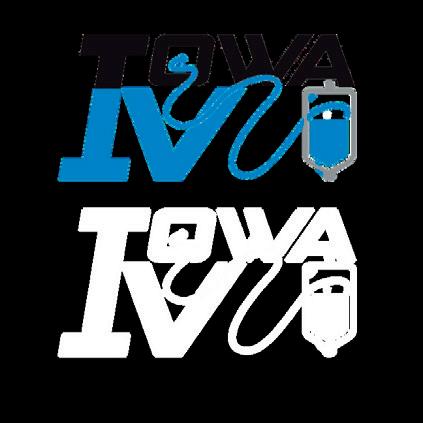
Agradecido. Agradecido era todo lo que podía pensar. Por haber sido físicamente capaz de llegar a ese combate, cuando el verano anterior me preguntaba si podría alcanzar la meta y permitirnos a ambos vivir este momento. Agradecido de haber tenido un sueño y de que me pagaran por ello.
Agradecido por haber podido perseguirlo y disfrutar de todo lo que conlleva el viaje. Y, sobre todo, agradecido por haber podido mantener mi salud, mi trabajo en la planta química y a mi familia”.
El objetivo de Juan Fourneau es jubilarse a los 55 años. Cuando no está en su trabajo en la fábrica, le gusta leer y escribir sobre finanzas personales, inversiones y otros temas que le interesan. Juan, casado y con dos hijos, se retiró de los cuadriláteros después de luchar en el circuito independiente durante más de 25 años. Luchó como luchador enmascarado mexicano bajo el nombre de Latin Thunder. Síguelo en Twitter @ LatinThunder1. Este articulo fue originalmente publicado en HumbleDollar. com
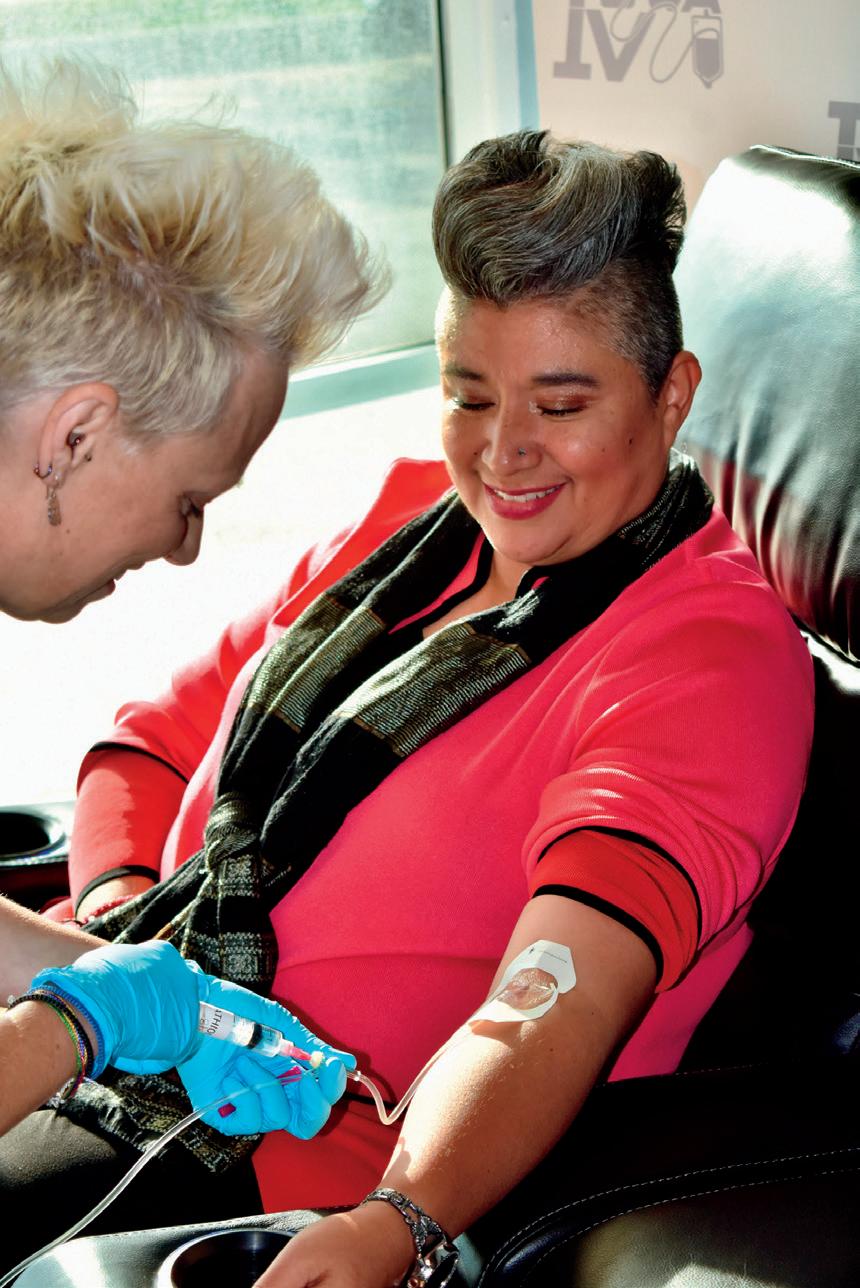

Quad Cities - No es habitual que un veterano de diez años en la policía cuelgue las esposas y tome en su lugar una guitarra, pero eso es exactamente lo que hizo el Latino estrella del country en ascenso Frank Ray hace sólo cuatro años. Y con el éxito de su single, “Country’d Look Good on You”, que entró en la lista Billboard Country Top 40 en 2021, él, junto con Kassi Ashton y Greylan James serán los artistas encargados de abrir el concierto de Old Dominion en su gira No Bad Vibes Tour, siendo los Quad Cities, en la Vibrant Arena su tercera parada el sábado 21 de enero.
“Estoy muy emocionado por conectar con nuevos fans”, dijo Ray. “La marca Frank Ray es todavía muy nueva y reciente, así que mi objetivo es salir y mostrar lo que podemos hacer y con suerte ganar algunos nuevos fans y conectar y hacer ese impacto con la música country que nos propusimos”.

Casi una década después de empezar su carrera como policía en Nuevo México, ganó una competición de bandas, cuyo premio fue abrir el concierto de Keith Urban. Con su banda poniendo en duda el talento que tenían, Frank optó una carrera de artista por sí solo y así nació Frank Ray. “La música siempre ha sido la pasión de mi vida”, dice Ray. “Es lo que he sabido que quería hacer con mi vida desde que era un niño. Dejé atrás una carrera muy estable así que no podía fracasar. Necesitaba triunfar por mi familia y volver para demostrar a todo el mundo y a mí mismo que me propuse hacer esto y lo hicimos”. Al hablar de ser uno de los pocos artistas latinos en la música country de hoy, Ray, cuyo verdadero nombre es Francisco Gómez, es muy consciente de su entorno y lo asume de todo corazón con una carcajada siempre a punto. “Soy muy abierto y bromeo mucho conmigo mismo y con mi banda”, dice Ray. “Contamos todos los chistes terribles que la gente piensa pero que probablemente nunca dirá. Hay que ser capaz de reírse de uno mismo. Te libera de la tensión”.
Y con esa actitud, Ray, está feliz de ser la cara de los latinos en la música country con la esperanza de que ayude a romper algunas barreras en la industria de la música que todavía están presentes hoy en día. “Siempre me he sentido bienvenido”, dijo Ray. “Algunas personas quieren apoyarme, pero si me apoyan un lado de

la moneda será como ‘sólo me estás apoyando porque soy mexicano, estás tratando de parecer más diverso’. Por otro lado, a la gente no le importa eso y sólo le gusta la música. Yo siempre he sido de dejar que la música hable por sí misma. No me importa”.
Ray no sólo se está ganando los oídos de los que escuchan su música, sino que también ha llamado la atención del Congreso en DC, ya que Ray está creando conciencia sobre la salud mental de los First Responders y siente que están en camino de hacer algo grande en 2023. “Cuando sirves primero a la comunidad, a menudo te pones a ti mismo en último lugar”, explicó Ray. “Así que quería expresar que hay formas sanas de sobrellevar la situación cuando se ayuda a la comunidad, y he tenido que luchar mucho para conseguirlo. Aún estamos trabajando en ello. Estamos trabajando con el Congreso en Washington para elaborar una legislación y conseguir fondos y, al mismo tiempo, desarrollar mi carrera para tener una plataforma más grande y poder hablar de este tema”.
Padre de dos hijas y con una tercera en camino, Ray se ha dado cuenta de que compaginar la vida familiar con la música conlleva sus retos, pero sabe que, al final, merece la pena cada kilómetro que recorre. “Es una paradoja”, explica Ray. “Para mantener a mi familia, tengo que abandonarla. Sinceramente, todo el respeto es para mi mujer. Hay que ser fuerte para llevar este estilo de vida”.
Mientras su estrella sigue creciendo, Ray espera inspirar a quienes le admiran, con la esperanza de que algunos salgan de su zona de confort como él y tengan éxito en lo que elijan. “Vengo de un pequeño pueblo de Columbus, Nuevo México, de apenas mil habitantes”, dice Ray. Está muy cerca de la frontera con México. Yo era muy pobre. Tenía lo mínimo, comencé desde abajo como muchos latinos. Pero tengo un sueño y sigo rodeándome de la gente adecuada, sé que nuestra cultura está llena de gente a la que no le da vergüenza trabajar duro. Hay que salir ahí y conseguirlo. La música de country es para todos”.
No se pierda la presentación de Fran Ray en el Vibrant Arena at the Mark el sábado 21 de enero. Él abrirá el concierto de Old Dominion en su gira No Bad Vibes Tour. Para conseguir entradas, visite vibrantarena.com
En muchos casos, las personas con el VIH pueden tomar una pastilla al día, lo que les ayudará a alcanzar lo que se denomina carga viral indetectable
Detectable
Indetectable

Cuando la carga viral de una persona es indetectable, protege su salud en general. También evita que el VIH se transmita a las parejas sexuales.
Obtenga más información en stophiviowa.org

La sífilis es una infección de transmisión sexual. Es más común y más fácil de contraerla de lo que crees. Los primeros síntomas son muy difíciles de notarlos, pueden incluir una llaga o sarpullido que no producen dolor.


La sífilis es curable , pero sin tratamiento puede provocar problemas de salud graves . Puede dañar permanentemente los ojos, el cerebro, el corazón y el sistema nervioso.
Si es sexualmente activo, asegúrese de realizarse un análisis de sangre para detectar la sífilis, como parte habitual de su rutina de salud.
Encuentre un lugar de prueba cerca de usted: gettested.cdc.gov/es Hay opciones disponibles gratuitas y de bajo costo.





Obtenga más información sobre la sífilis en ashasexualhealth.org/syphilis .


Quad Cities - It’s not often that a ten-year veteran on the police force hangs his handcuffs up and picks up a guitar instead, but that is exactly what rising Latino country star Frank Ray did just four years ago. And with the success of his single, “Country’d Look Good on You”, entering the Billboard Country Top 40 list in 2021, he, along with Kassi Ashton and Greylan James will open for Old Dominion on their No Bad Vibes Tour, with the Quad Cities, Vibrant Arena being their third stop on Saturday, January 21. “I’m most excited about connecting with new fans,” said Ray. “The Frank Ray brand is still very new and fresh, so my goal is to go out and show what we can do and hopefully gain some new fans and connect and make that impact with country music that we set out to do.”
It was almost a decade into his career as a police officer in New Mexico that he won a battle of the bands of sorts, the prize being an opening spot for Keith Urban. With his band doubting the talent they had, Frank chose to go about this as a solo act and Frank Ray was born. “Music has always been my life’s passion,” said Ray. “It’s what I’ve known I wanted to do with my life since I was a kid. I left behind this really steady career so there was no way I could fail. I needed to succeed for my family and go back to prove to everyone and myself that I set out to do this and we did just that.”
When talking about being one of a handful of Latino artists in country music today, Ray, whose real name is Francisco Gomez, is very aware of his surroundings and embraces it wholeheartedly with a laugh always ready on deck. “I’m really open and joke a lot about myself and self-deprecate a ton with myself and my band,” said Ray. “We crack all the terrible jokes that people are thinking but probably never say. You have to be able to laugh at yourself. It cuts the tension for sure.”
And with that attitude, Ray, is happy to be the face of Latinos in country music in hopes that it will help break some barriers down in the music industry that are still present today. “I’ve always felt welcome,” said Ray. “Some people want to support me, but if they support me the other side will be like ‘you are only supporting me because I’m Mexican, you’re trying to look more diverse.’ On the other side, people don’t care about that and just like the music they do because I’m Mexican. I’ve always been like, let the music speak for itself. I don’t really care.”
Not only is Ray winning over the ears of those that listen to his music, he has also got the attention from Congress in DC as Ray is bringing awareness to mental health for First Responders and he feels they are on track for something big in 2023. “When you serve the community first, you often put yourself last,” explained Ray. “So, I wanted to express that there are healthy ways to cope when helping your community and I struggled a lot with that. It’s still a
work in progress. We are working with congress in DC to build up some legislation and get some funding and also at the same time build up my career so I have a bigger platform for this so we can talk about this issue.”

A father of two daughters with a third on the way, Ray has found that balancing being a family man and a music man comes with his challenges, but he knows, in the end, it’s worth every mile that he travels. “It’s such a paradox,” explained Ray. “To support my family, I have to leave them. Honestly, the respect all goes to my wife. It takes a strong individual to live this lifestyle.”
As his star continues to rise, Ray hopes to inspire those looking up to him, hoping that some step out of their comfort zone as he did and have success in whatever they choose. “I come from a small town in Columbus, New Mexico, barely one thousand people,” said Ray. It’s so close to the Mexican border. I was dirt poor. I had the bare minimum, the Latino starter kit. But having a dream and surrounding myself with the right people, I know our culture is full of people that are not shy of hard work. Go out there and get it. Country music belongs to everybody.”
Don’t miss Fran Ray performing at the Vibrant Arena at the Mark on Saturday, January 21. He will be opening for Old Dominion on their No Bad Vibes Tour. For tickets visit vibrantarena.com

obra, los expertos del sector afirman que los constructores ya tenían dificultades para contratar y retener a trabajadores de la construcción desde la Gran Recesión. Cientos de miles de trabajadores fueron despedidos o abandonaron por completo el sector tras el desplome del mercado inmobiliario en 2007, y las empresas sintieron el impacto después de que la economía se recuperara a principios de la década de 2010, dijo Patterson.

Para satisfacer la demanda de mano de obra sólo este año, el sector necesitó 650,000 trabajadores de la construcción más, según Associated Builders and Contractors. El aumento de la inflación, la demanda de salarios más altos y el envejecimiento de la mano de obra son sólo algunos de los factores que contribuyen a la escasez, informó ABC. En los últimos años, el sector ha experimentado un descenso en el número de trabajadores jóvenes y una mayor proporción de trabajadores mayores que pronto podrán jubilarse. Por eso Deluca, de 45 años, creó la Escuela de Construcción de Iowa. Su objetivo es devolver la chispa a los oficios y animar a los jóvenes del área metropolitana de Des Moines a estudiar carreras relacionadas con la construcción.
Y quiere que las mujeres sepan que también hay un lugar para ellas.
En 2020, la Oficina de Estadísticas Laborales de Estados Unidos informó que aproximadamente uno de cada 10 trabajadores de la construcción era mujer, una cifra que apenas ha variado en los últimos años. Esto recuerda a Deluca que hay mucho margen de crecimiento.
“No hay nada que las mujeres no puedan hacer”, afirma.
“Estuve en el campo durante años. Sé que hace frío. Sé que sudamos. Sé por lo que pasamos. Sé cómo nos tratan los hombres”.
Llegó a Estados Unidos con 100 dólares y grandes sueños
Deluca siempre ha tenido ambición.
A los 15 años, decidió que Brasil era demasiado pequeño para albergar sus grandes sueños. Una economía en transformación le bastó para dejar atrás su país natal y su familia y poner los ojos en Estados Unidos.
“Mucha gente me pregunta: ‘¿Por qué viniste aquí?’ Yo respondo: ‘Para ganar más dinero, para tener una vida mejor’”, explica.
Deluca tenía 20 años cuando llegó a Estados Unidos en 1998, con 100 dólares en el bolsillo y ganas de trabajar. Primero llegó a Fort Lauderdale, donde se alojó en casa de una prima durante una semana mientras buscaba trabajo y un lugar donde vivir.
Durante unos años, Deluca dijo que trabajó en un empleo tras otro. Limpiaba casas, era camarera y cocinera. No fue hasta que conoció en Florida a Joseph Cichowski, contratista general y antiguo propietario de Southeast Constructors, cuando su vida y su trabajo empezaron a cambiar. Cichowski contrató a Deluca, y ella ayudó a renovar casas residenciales, sobre todo pintando. Pero Deluca quería hacer más.
En el sector de la construcción, dicen Deluca y Cichowski, se trata de tomar la iniciativa. No hay nadie que te enseñe cómo hacerlo. Observas, aprendes y haces. Y vuelves a
hacerlo si no lo haces bien a la primera.
“La única forma de fracasar es si te rindes, ¿cierto? Tarde o temprano lo conseguirás”, dice Cichowski, a quien Deluca encargó la enseñanza y la elaboración del plan de estudios de la escuela de construcción.
“Cuando tratas de desarrollar habilidades y todo eso, tienes que centrarte en eso y poner tu 100% ahí”, dijo.
La construcción es una carrera “admirable” que requiere conocimientos y formación

Cichowski y Deluca afirmaron que a menudo se estereotipa a los trabajadores de la construcción como personas que no son lo suficientemente buenas como para ir a la universidad o que necesitan un trabajo sólo para llegar a fin de mes. Ninguna de las dos cosas es cierta.
Instalar paneles de yeso, mezclar y verter cemento, cortar madera perfectamente recta, manejar maquinaria pesada como pavimentadoras de asfalto o topadoras, o incluso colgar repisas o un televisor en una pared requiere conocimientos y formación, dijeron.
“La construcción es una profesión admirable”, afirma Cichowski, de 53 años y residente en Des Moines. “Es noble. Se construyen cosas. Construyes las carreteras por las que circulamos. Estamos construyendo los puentes que cruzan nuestras familias”.
Cichowski y Deluca se mudaron a Iowa hace unas décadas.
Deluca adquirió más habilidades mientras trabajaba para Cichowski. Como su confianza iba en aumento, le dijo a Cichowski que ya no quería trabajar para él, sino con él. Quería ser su socia y decidió obtener la licencia de contratista general.
En 2013, tras acumular más de una década de experiencia, Deluca dio un paso aún más audaz: Compró la empresa de Cichowski y se convirtió en la única propietaria.
“Él siempre dice: ‘Ahora trabajo para ti’”, dijo Deluca, riendo. “Y es verdad. Sé que trabaja para mí”.
Aunque los latinos constituyen una gran parte de la mano de obra de la construcción, siguen estando infrarrepresentados en los puestos directivos. Aproximadamente el 14% de los directivos de la construcción son latinos, según la Oficina de Estadísticas Laborales de EE.UU. de 2020. Las mujeres también están muy infrarrepresentadas en los puestos directivos, con sólo un 9%, según Zippia, un sitio de empleo.

“La idea errónea es que no es un lugar para mujeres”, afirma Cichowski. “He estado en muchas reuniones en las que los organismos públicos tenían esa actitud, y no creo que sea correcta. Perlla es testimonio de ello. Es un sector dominado por los hombres, pero no debería ser así. Las mujeres pueden participar”.
El sector de la construcción se convirtió en “un trampolín hacia algo mejor”
Deluca afirma que la Gran Recesión les obligó a ella y a Cichowski a ver más allá de las reformas de viviendas. Hambrientos de trabajo, encontraron la oportunidad de reparar unos muros destruidos por la inundación de 2008 en Cedar Rapids. También emprendieron otros proyectos en Iowa, como la restauración de Normandy Drive en
Iowa City, la creación de un estacionamiento adaptado a la ADA para el Blank Park Zoo de Des Moines y la repavimentación del tablero del Women of Achievement Bridge. Hasta la fecha, Southeast Constructors ha realizado docenas de proyectos en cinco estados.
Deluca recuerda un proyecto en particular en el que su empresa recibió el encargo de rehabilitar el exterior de la casa del ex presidente Harry Truman en Independence, Missouri.
“Ni siquiera soy de este país y me dejan arriesgarme a quemar la casa”, bromea.
Con la vista puesta en el futuro, Deluca reflexionó sobre su carrera y su nueva escuela. Cree que es su oportunidad de dar un paso adelante y animar al próximo grupo de estudiantes -algunos de los cuales pueden ser mujeres o inmigrantes, o ambas cosas, como ella- que quieren una oportunidad de tener una vida mejor.
“Creo que el hecho de haber realizado tantas cosas me ayuda ahora, quizá con los estudiantes”, afirma. “La gente me pregunta: ¿Por qué la escuela? Porque yo estaba allí. Estuve limpiando mesas. Quiero demostrarles que se puede hacer algo mejor, no que limpiar mesas tenga nada de malo. Sólo digo que es un trampolín hacia algo mejor”.
F. Amanda Tugade cubre temas de justicia social para el Des Moines Register. Escríbele a ftugade@dmreg.com o síguela en Twitter @writefelissa.
Foto por Bryon Houlgrave / The Register
It’s Friday afternoon in late October, and Perlla Deluca is walking down a quiet, empty hallway of an old school building on Des Moines’ southeast side.
Deluca’s boisterous voice and the click-clack of her high heels are the only signs of life inside Percy Hoak Elementary School, a roughly 18,000-square-foot property that’s been vacant for nearly a decade and once was thought to be a potential site for affordable senior housing. Deluca’s pink nails and turtleneck stand out against her black attire and the building’s bare walls.
Like an artist ready to unveil a new project, Deluca, an entrepreneur and owner of the Des Moines-based general contractor firm Southeast Constructors, said her vision for this space is simple: She wants to create an inclusive school to equip the next generation of young adults — young women, especially — with the right set of trade skills to work in construction.
Deluca was chosen as one of the Des Moines Register’s 15 People to Watch in 2023 because, come next year, she and her team plan to reopen the former elementary school at 1801 McKinley Ave. under a new name — the Iowa School of Construction — and welcome their first batch of students. The students, 20 of whom have already signed up, will take a 12-week course that includes lessons on the basics of carpentry, welding, masonry, power tools and
other machinery. Registration is ongoing, with classes set to start in February.
“If you ever thought about building something, creating something, if you ever thought about buying a house or getting into flipping (houses), or if you want a job working for the city, or government or something constructionrelated, I would say this is your opportunity to get a feel for that,” she said. Tuition to the school, which received $50,000 from Iowa Workforce Development in 2022, is set at $4,200 for the three-month course.
And with Latinos making up at least 30% of the construction workforce, the school plans to offer classes in languages other than English to help students still learning the language. Deluca, who emigrated from Brazil to the U.S. two decades ago, will step in to translate courses into Spanish and Portuguese.

“People like Perlla, doing the school that she’s doing and offering different languages … it’s removing barriers,” said Brandon Patterson, who works for the Home Builders Association of Des Moines to increase the number of workers in the industry.
Construction industry scrambles to find enough workers
Deluca said the idea for the construction school came out of what she saw as a dire need in her industry.
Though the COVID-19 pandemic worsened a labor shortage, industry experts say builders already struggled to recruit and retain construction workers since the Great Recession. Hundreds of thousands of workers were let go or left the industry entirely after the housing market crashed in 2007, and firms felt the impact after the economy picked back up in the early 2010s, Patterson said.
To meet the demand for labor this year alone, the industry needed 650,000 more construction workers, according to the Associated Builders and Contractors. Rising inflation, demands for higher wages and an aging workforce are just some of the contributing factors to the shortage, ABC reported. The industry in recent years has seen a dip in younger workers and a greater proportion of older workers soon to be eligible for retirement.
That’s why Deluca, 45, created the Iowa School of Construction. She seeks to put the spark back into trade skills, encouraging the Des Moines metro’s young adults to explore careers in construction.
And she wants women to know there is a place for them there, too.
In 2020, the U.S. Bureau of Labor Statistics reported about one in 10 construction workers was a woman — a figure that has seen little change in recent years. It reminds Deluca that there’s plenty of room for growth.
“There’s nothing women can’t do,” she said.
“I was in the field for years. I know it’s cold. I know we sweat. I know what we go through. I know how the guys treat us.”
She arrived in the United States with $100 and big dreams
Deluca always has been ambitious.
At 15, she decided Brazil was too small to hold her big dreams. An economy in flux was enough for her to want to leave her home country and family behind, setting her eyes on the United States.
“A lot of people ask: ‘Why do you come here?’ I said, ‘To make more money, to have a better life,’” she said.
Deluca was 20 when she first arrived in the U.S. in 1998 with $100 in her pocket and the will to work. She first came to Fort Lauderdale, where she stayed with a cousin for a week while chasing leads for jobs and a place to call her own.
For a few years, Deluca said she worked job after job after job. She cleaned houses and was a waitress and a cook. It wasn’t until she met Joseph Cichowski, a general contractor and former owner of Southeast Constructors, in Florida that her life and work began to shift. Cichowski hired Deluca, and she helped renovate residential homes, mostly by painting.
But Deluca wanted to do more.
In the construction industry, Deluca and Cichowski said, it’s all about taking initiative. There’s no one to really show you the ropes. You watch and learn and do. And you do it again if you don’t get it right the first time.
“The only way you’re going to fail is if you quit, right? You will get it sooner or later,” said Cichowski, whom Deluca tapped to teach and curate the curriculum for the construction school.
“When you’re trying to develop skills and everything, you have to be focused on that and you have to put your 100% in it,” he said.


Cichowski and Deluca said construction workers oftentimes are stereotyped as people who weren’t good enough to go to college or needed a job just to make ends meet. Neither is true, they said.
Installing drywall, mixing and pouring concrete, cutting wood perfectly straight, operating heavy machinery like asphalt pavers or dozers, or even hanging shelves or a TV on a wall takes knowledge and training, they said.
“Construction is a career, and it’s an admirable one,” said Cichowski, 53, of Des Moines. “It’s noble. I mean, you’re building things. You’re building the roads we drive on. We’re building the bridges our families cross.”
Cichowski and Deluca moved both the business and themselves to Iowa a few decades ago.
Deluca collected more skills while working for Cichowski. With her confidence growing, she told Cichowski she no longer wanted to work for him, but rather with him. She
wanted to be his business partner and decided to become a licensed general contractor.

In 2013, after collecting more than a decade of experience, Deluca made an even bolder move: She bought out Cichowski’s company and became the sole owner.
“He always says: ‘Now I work for you,’” said Deluca, laughing. “It’s true. I know he works for me.”
While Latinos make up a large part of the construction workforce, they remain underrepresented in management positions. Roughly 14% of construction managers are Latino, according to the 2020 U.S. Bureau of Labor Statistics. Women also are largely underrepresented in management positions at just 9%, according to Zippia, a career site.



“The misconception is it’s not a place for women,” Cichowski said. “I’ve been in plenty of meetings where government agencies had that attitude, and I don’t think it’s right. Perlla is testimony to that. It’s a male-dominated industry, but it shouldn’t be. Women can get involved.”
Construction field became ‘a steppingstone to something better’
Deluca said the Great Recession forced her and Cichowski to look beyond home renovations. Hungry for work, they landed on an opportunity to repair some brickwork destroyed by the 2008 flood in Cedar Rapids. They also picked up other projects in Iowa including restoring Normandy Drive in Iowa City, creating an ADA-compliant parking lot for Blank
Park Zoo in Des Moines, and resurfacing the deck of the Women of Achievement Bridge.
To date, Southeast Constructors has completed dozens of projects across five states.

Deluca remembered one particular project where her company was tasked to rehab the exterior of former President Harry Truman’s home in Independence, Missouri.
“I’m not even from this country, and they’re going to let me take a chance on burning the house,” she joked.
With a focus on the future, Deluca reflected on her career and her new school. She believes it’s her chance to pay it forward and lift up the next group of students — some of whom might be women or immigrants, or both like herself — who want a chance at a better life.
“I do think the fact that I did so many things helps me now, maybe with the students,” she said. “People ask (me): ‘Why the school?’ Because I was there. I was cleaning tables. I want to show them that you can do better — not that (there’s anything) wrong with cleaning tables. I’m just saying it’s a steppingstone to something better.”
F. Amanda Tugade covers social justice issues for the Des Moines Register. Email her at ftugade@dmreg.com or follow her on Twitter @writefelissa.
Photos by Bryon Houlgrave / The RegisterMenudo, Birria, y Quesabirrias acompañadas de su consomé y su salsa bien picosita

Todos los domingos en el Mercado del 900 E. Army Post Rd. en Des Moines
Tortillas hechas a mano ahí mismo. Además café de olla, aguas naturales, limonada con pepino horchata y piña. Visitenos, los esperamos.


Des Moines, IA - In October, Rubén Vázquez began his new role as the Chief Diversity, Equity, and Inclusion Officer for United Way of Central Iowa. Vázquez moved his family from the Twin Cities to become the first person hired to focus on equity and inclusion for the agency. For the past twenty years Vázquez devoted his career to social justice, advocacy and community-focused positions. His passion comes from his lived experience. Originally from Mexico, Vázquez knows first-hand how scary and difficult it is to live as an outsider and used that as fuel for his career. Vázquez doesn’t see diversity, equity, and inclusion (DEI) as a trend, but a movement for people like him who have faced discrimination for things they cannot help like an accent, brown skin, or an international birthplace.
His goal for his new position is to foster
unity in Des Moines, especially within the Latino community, which is on-track to be the largest ethnic group in Iowa by 2035.
“The bigger the community gets, the more difficult it becomes for us to see ourselves as one. If we could be more of a ‘we,’ we could be much more powerful than we are. Think about the social and political power we could have if we were working as a we.” He cites limited resources for vulnerable populations as a key cause of competition among Latino-serving agencies and hopes that his focus on equity within United Way of Central Iowa programs can combat the, “quitate tu para ponerme yo,” mentality he saw in Minneapolis. His plan is to approach the United to Thrive strategic plan with internal and external equity initiatives that create mutually beneficial collaborations that unify agencies to help them meet their fullest potential for impact.
The United To Thrive strategic plan focuses on five elements identified from a needs assessment conducted by United Way of
Central Iowa that include essential needs, early childhood success, education success, economic opportunities, and health and well-being. Vázquez wants to weave key indicators of success within each element that centers on equity. He sees his job as being the person to challenge the work United Way is doing to ensure they don’t lose track of how inequities within existing systems pose barriers for marginalized communities. In other words, he sees it as his duty to lead the effort to create opportunities and changes that allow historically excluded people access to the resources they need. “We don’t want a piece of the pie, we want to be part of the whole pie.” Vázquez’ approach is one of partnership with his colleagues at United Way. Currently, he is on what he calls a “Listening Tour” to talk to each staff member and get their thoughts about what they think is working and where the agency needs more work around DEI issues that are effective within the agency, as well as to their constituents. “People are excited about me coming on board to do this work, but they are also nervous and scared about doing this work because they may see parts of themselves they may not like.” He knows to tread lightly and strategically as he pushes his peers out of their comfort zone to involve them in the work to create equity, while being careful not to push so hard that they become unwilling to be part of the necessary changes that requires everyone’s talent and perspective. He is prepared for the challenge of leading United Way to take an active role in changing systems in the name of equity and inclusion.
Since joining the agency, Vázquez has been most impressed by their attention to detail, especially when addressing him. It is the first place he has worked that has taken the time to spell his name correctly, using the appropriate accents in his first and last name. “What that told me was that they value me as a person.” He was told it was intentional and to Vázquez it demonstrated that the agency is willing to put in the work to get DEI right because they understand how important it is. He wants people to know that United Way is do-
ing a lot of great work for the community. “It may not look the way the community wants it to look and it may not be moving as fast as the community wants it to move, but we are doing a lot of good work for the broader community.” Vázquez warns that to meet their impact goals, he is not the only one who should be focused on DEI for the agency. In order for United to Thrive to reach the metrics of success within the campaign, everyone has to work together with a focus on making sure all initiatives address gaps in equity and access for all. “I am not an expert in DEI. I am an expert in my own lived experience. I bring my lived experience into my work, but there are so many things I still have to learn.” He is committed to making diversity, equity and inclusion part of how United Way operates and understands that as the first to take on the task, he will be learning alongside his peers. “It’s OK for me to say I don’t know that; let’s figure that out.” He hopes that with his help, DEI-centered business practices will become something bigger and more sustainable. “It is not a trend; it is a big deal.”
When asked what diversity, equity and inclusion means to him, he recalled times he was followed while shopping at Target; when he was asked for a green card when pulled over for a traffic violation instead of being asked for his license; and how his mother was refused services because she didn’t speak English. When he became a citizen, he went as far as ordering a passport card that he carries with his license to show whenever his immigration status is questioned. While those incidents were painful, infuriating, and unfair, they are why he is so dedicated to making sure inclusion, understanding, and equity is at the forefront of his work. “I have been living in this country for forty-three years. I only lived in Mexico for ten. I belong here.”
But he knows he can’t do it alone. “In order for our community to be successful, we have to become engaged in this work because it can only happen if we’re all doing it together. It’s going to take a broader sense of community to get it done.”

Escucha Mi Voz Iowa is the first group anywhere in the country to roll out the $700 million USDA program
West Liberty, IA - After two months of list-building and eligibility screenings, Escucha Mi Voz Iowa became the first organization anywhere in the country yesterday to begin handing out $600 pandemic relief checks to farmworkers and meatpacking plant workers as part of the U.S. Department of Agriculture’s Farm and Food Worker Relief program.
On Monday, January 2, the group handed out more than $150,000 in direct cash payments to over 300 Congolese, Burmese, and Hispanic farm and food workers. The economic stimulus will begin flowing as soon as banks open this morning after the New Year holiday.
Escucha Mi Voz members say they will continue to dole out the $600 checks to over a thousand more during the course of this week in Iowa City, West Liberty, and Columbus Junction.


At the same time yesterday, Escucha Mi Voz members in West Liberty began processing the city’s new American Rescue Plan-funded utility relief program, where eligible city residents can receive a $400 credit to their electric, water, or internet bills. The program
was designed and passed by the West Liberty city council late last year after excluded workers spent over a year standing up and speaking out for the direct cash payments.
“Seventy-six applied in West Liberty for utility assistance yesterday,” Father Guillermo Trevino, Jr. confirmed. Utility relief application clinics at St. Joseph Catholic Church will continue tonight, Thursday, and Friday from 5-9pm in the parish community center.

The $700 million Farm and Food Worker Relief program was contracted by USDA to a handful of national organizations like the United Farm Workers Union, United Food and Commercial Workers Union International (UFCW), and Catholic Charities USA.

Catholic Charities USA received nearly $10 million to administer the program and sub-awarded Escucha Mi Voz Iowa $1.357 million to identify and distribute aid to 1,800 eligible workers in un-unionized plants in Columbus Junction, West Liberty, and farmworkers in Washington County.


Eligible farm and food workers who worked at least one day since January 27, 2020 in a qualified industry can apply for a direct cash payment of $600.



I lost a match on Nov. 12 against my former tag-team partner, Kevin Gutierrez, who wrestles under the colorful name “Corn Boi.” It was a classic Lucha Libre stipulation match. I put my mask on the line, and Kevin would cut his shoulder-length hair if he lost. Mask versus hair—or, as they say in Mexico, mascara versus cabellera.

We had many tried-and-true plot lines going for us. Teacher versus student. Old friends and tag partners who were now fighting furiously against each other. Older, bitter, crotchety veteran wrestler—that’s me—frustrated with this not-so-serious newer generation.
It was a good story. All the while, I knew how it would end—with me losing my mask and announcing my retirement from wrestling. I’ll wrestle a goodbye match or two next summer, but essentially, I was done.
When I put on the mask at age 40, I remembered a line from the great wrestling journalist Dave Meltzer. He wrote the obituary for Junkyard Dog, the African-American grappler who was a Main Event star and drew tons of money in the New Orleans area and later in the World Wrestling Federation. “If he had kept his weight under control and
continued training, he could have been a star into his 50s like Ric Flair, The Crusher or Dick the Bruiser.”
Right there, Meltzer had given me the formula for longevity in the sport.
Ric Flair also said in his podcast that the enemy of any professional wrestler was inactivity. So, for the past nine years, I’ve tried to keep a regular wrestling schedule. If I didn’t have a match, I headed up to the Black & Brave wrestling school in nearby Davenport, Iowa, and worked out in that hard ring.
It all helped. My work actually improved as I had regular access to a ring for the first time in my career. My body felt good. I eliminated the heavy weights from my training, especially exercises that stressed my lower back.
I kept my weight under control. At five feet nine inches, I never allowed myself to go above 230 pounds, even during the holidays. Most of the time, the scale read around 215, and occasionally I got to a fit 208 pounds. With my tan, and dedicated work in the gym, I looked the part.
Kevin and I worked hard at the school. I insisted we train the way we performed in front of a crowd. It was invigorating to finally be able to work on my craft in a way I had never done.
When I was young, I wasn’t willing to move to locations that would have given me the chance to get in the ring and train with other pros. To be in a position to get to work with Kevin was an opportunity I couldn’t pass up. Even at age 48.
After several long practice matches last summer, I could feel the repercussions. A headache was a given. When I went to wrestling school in 1994, we were hyper-focused on our bodies. Our neck, back, shoulders and knees were our injury concerns. Those were the dangers that weighed on our minds.
But our minds—our brains—were not a concern. Now, it was becoming one for me. The science of concussions and chronic traumatic encephalopathy, a progressive brain disease, are today well-known and ominous.
The physicality of the sport also let me know that, while I could handle both the rigors of the training and my young contemporaries, my recovery was slower. It took me days or a week to recover fully from a 15-minute training match. What was most heartbreaking was seeing something so clearly at my advancing age that I never thought about in my 20s. I had talent. Some of the kids who graduated from the intense, three-month training program at the school didn’t have the same aptitude for the life of a wrestler. I was an athlete. Some others didn’t move as naturally in the ring. I saw countless young men hit the weights hard and still not look all that impressive, considering the time they were putting in.
My body had always responded to training. I loved pumping iron, which some wrestlers considered more of a required chore. Lifting weights cemented what I had been feeling since I turned 40. Wrestling was my calling.
I had pursued it, yes. But I had never given it the time, sweat and dedication that the craft demanded. I was always negotiating the price. As I approach turning 50 next March, Father Time was telling me I was pushing the limits.
It didn’t matter how long or consistently I trained—the end was near. Especially if I wanted to dictate my last chapter, rather than have it decided for me.
As we age, we begin to feel more physically vulnerable. You hesitate to climb on a roof or step too high on a ladder. All because you see or experience firsthand the physical dangers that life presents. You lose the invincible feeling of your youth, the blissful ignorance you had in your 20s.
When I would climb to the top rope of the ring to deliver an exciting move, my balance was not what it once was. My awareness of the risk I was taking, however, was everpresent.
Pursuing your passion, versus following the safe route, is something folks have been dealing with for many centuries. HumbleDollar’s editor offered this great piece of advice a while back: “I’d put in a plug for earning and saving starting in our 20s, so we can pursue our passions in our
Continues from last page
28.It will be on display at the Des Moines Art Center until January 15, 2023.
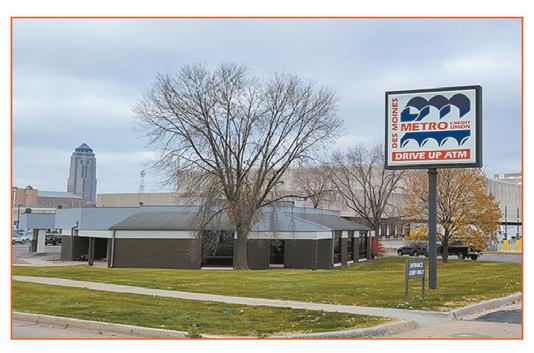
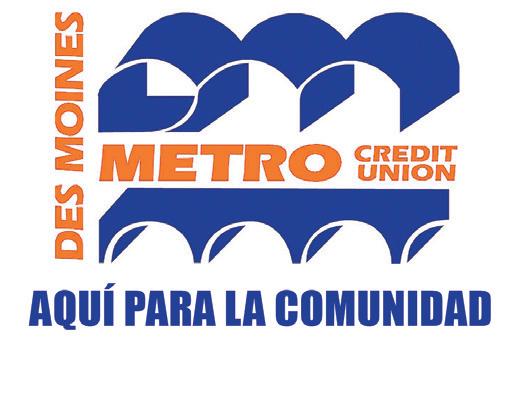
50s, when we likely have a better idea of what’s important to us.”
Alarcón Avila may have been educated as a biologist, but art feeds her soul. “I love biology. It gave me the capability to observe, investigate and analyze. At the end of the day, we are all humans. We have feelings and complexities that are hard to analyze, but art helps to touch souls. I am proud to represent people who look and talk like me, and show kids that look like mine, so they can see themselves in my work.”
After the match, my kids and I headed to Applebee’s for a late-night meal. I told them this would be an aspect of the business I’d miss. My wallet was full from the generous pay. We drew a great crowd and the promotor paid me well—$300—plus my daughter sold lots of merchandise. I came home with more than $600 in my pocket.
The match was good. I had delivered in the ring. For the fans, for the promotion company, for Kevin. My kids and I were all smiling and enjoying the meal and the glow from the evening. It was nearing midnight, well past my bedtime. But I knew the euphoria from the evening would keep me up late.
A few days after the show, Kevin and I had a chance to talk on the phone. After our conversation about the past few days,
he asked me how I’d felt at the end of our match. How did it feel in the ring taking off the mask with my sister, my nephews and my family in the audience? With the fans and wrestlers all watching and thanking me for my career?
Grateful. Grateful was all I could think of. To have been physically able to get to that match, when the summer before I was questioning if I could reach the finish line and allow us both to have this moment. Grateful to have had a dream, and to get paid for it.
Continues from last page LET US CATER YOUR PARTY!
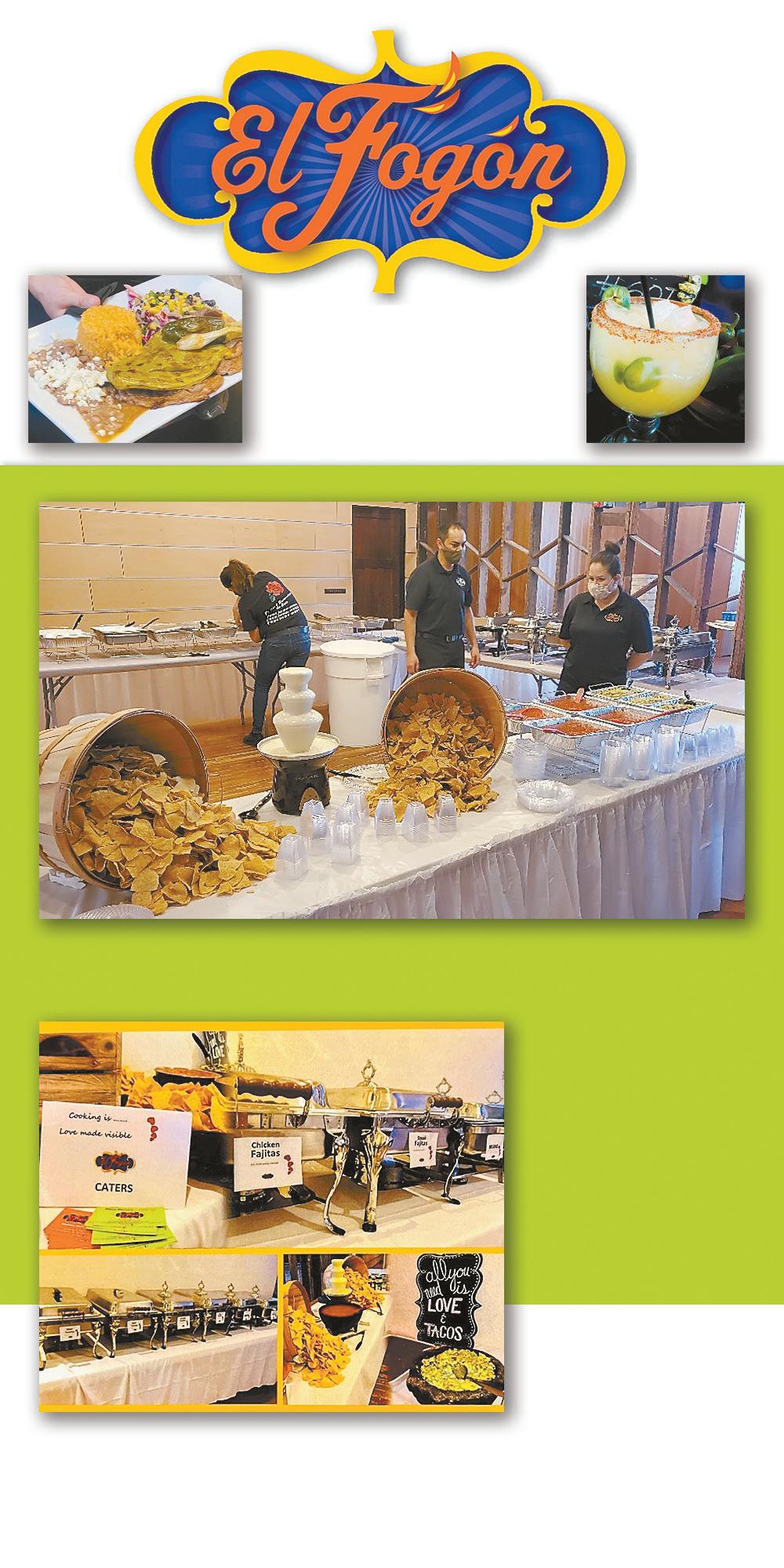
Grateful to have been able to pursue it and enjoy everything that came with the journey. And—most of all—grateful that I was able to maintain my health, my job at the chemical plant and my family along with it.
Juan Fourneau’s goal is to retire at age 55. When he isn’t at his manufacturing job, he enjoys reading and writing about personal finance, investing, and his other interests. Juan, who is married with two children, retired from the ring after wrestling on the independent circuit for more than 25 years. He wrestled as a Mexican Luchador under the name Latin Thunder. Follow him on Twitter @ LatinThunder1. This article was originally published on HumbleDollar.com
Some of the masks and photos of the Iowa Artist 2022: Miriam Alarcón Avila exhibit at the Des Moines Art Center.
you can also see the Day of the Dead ofrenda designed by Alarcón Avila and brought to life by her and a committee of volunteers who honor heroes like the luchadores captured by Alarcón Avila’s camera. The artist herself will be back Sunday November 13 for an “Artist Lecture + Exhibition Reception” from 1:30 PM to 4 PM. Miriam Alarcón Avila and curatorial manager Laura Burkhalter will talk about the artistic process, the significance of community making, the gifts of heritage, and leading creative acts in our time. Don’t miss this great opportunity to meet the artist and check out her exhibit and the Day of the Dead ofrenda designed by her. For more information about Alarcón Avila, please visit her website www. miriamalarconavila.com. @ElFogonWdsm @ElFogonWestGlen 5465 Mills Civic Parkway Suite 101 West Des Moines Call (515) 221-7981

WHERE A NEW TORTILLA IS BORN EVERY DAY! We also cater for bigger events Call us to for date availability! También atendemos eventos grandes. Llámanos para disponibilidad de fechas
For your office party or for your friends and family let El Fogon do the cooking!


Davenport, IA - It’s the new year, but the Figge Art Museum already has its eyes on a bigger new year – 2025 –which expects to be momentous in many ways.
Not only is the downtown Davenport landmark planning to celebrate the 20th anniversary of its sleek glass building (which opened Aug. 6, 2005), and the 100th anniversary of the original Davenport Municipal Art Gallery.
Early 2025 is when the four-story Figge (at 225 W. 2nd St.) hopes to have its long-planned $4-million LED lighting project completed as part of the ambitious Main Street Landing along the Davenport riverfront.
“That would be a wonderful way to celebrate the centennial,” Patrick Downing, development director for the Figge, said recently.
The new state-funded project, “Evanescent Field,” is by internationally acclaimed light artist Leo Villareal. He is known for his site-specific light installations, including San Francisco’s Bay Bridge, The Bay Lights; Illuminated River, a public work of art that unites 9 London bridges through one artwork; Multiverse, a tunnel installation at
the National Gallery of Art; and more.

Villareal uses binary code and simple structures to create complex light sequences through custom software that incorporates a site’s environment, creating a “digital campfire” around which people can gather to experience art. Lighting the Figge is an electrifying dream about 20 years in the making.
When British architect Sir David Chipperfield designed the museum’s current building, the original intent of both the architect and the QC community was to illuminate its glass façade to provide an ethereal glow at night, executive director Michelle Hargrave said recently.
Cost overruns during construction prevented this from happening, but over the years an idea arose to move beyond conventional building lighting to transform the Figge through light and art, making it a public artwork that all in the community can experience.
The idea to make it a transformational, unforgettable work of art (giving new life to the Davenport skyline) happened around 2015 after the Figge did some community focus groups.
“People said they lamented the fact we didn’t move for-

ward with the lighting of the building,” Hargrave (who’s been in the job three years) said. “The Figge is a jewel during the day, but at night it goes dark. The whole block is dark.”
The previous director Tim Schiffer said instead of just lighting the building from the outside, they wanted to make a bigger statement and light it from within, Hargrave said, noting they engaged Villareal in 2015.
The light designer visited the Figge that year, experimenting with different colors.

Through the museum, Villareal recently said: “I am honored and excited by the invitation to create a public artwork called Evanescent Field at the Figge Art Museum. This lighting sculpture will be integrated into David Chipperfield’s stunning architecture with the goal of activating the museum through sequences of undulating light for everyone in the Quad Cities to enjoy.”
Chipperfield said: “I am delighted to hear that the original plan to illuminate the façade will finally become a reality and look forward to seeing the realized project personally as soon as possible.”
Villareal did a basic design concept years ago, but the museum didn’t have the money for what would be a $4-million plan, Hargrave said. Schiffer unsuccessfully applied for a National Endowment for the Arts grant, and when Hargrave started, it was mentioned to her early on as a priority project.
“It would be really great to light the building,” she said. In early 2020, they met with David Raver of RDG Lighting in Des Moines, to discuss the project.
There will be 3,000 feet of LED strips placed through the museum, and fixtures that can withstand 150-degree temperatures, Hargrave said. The total of 1,100 LED lights will be placed between the two walls, and a server will control the light programming, determining the sequence of the patterns.
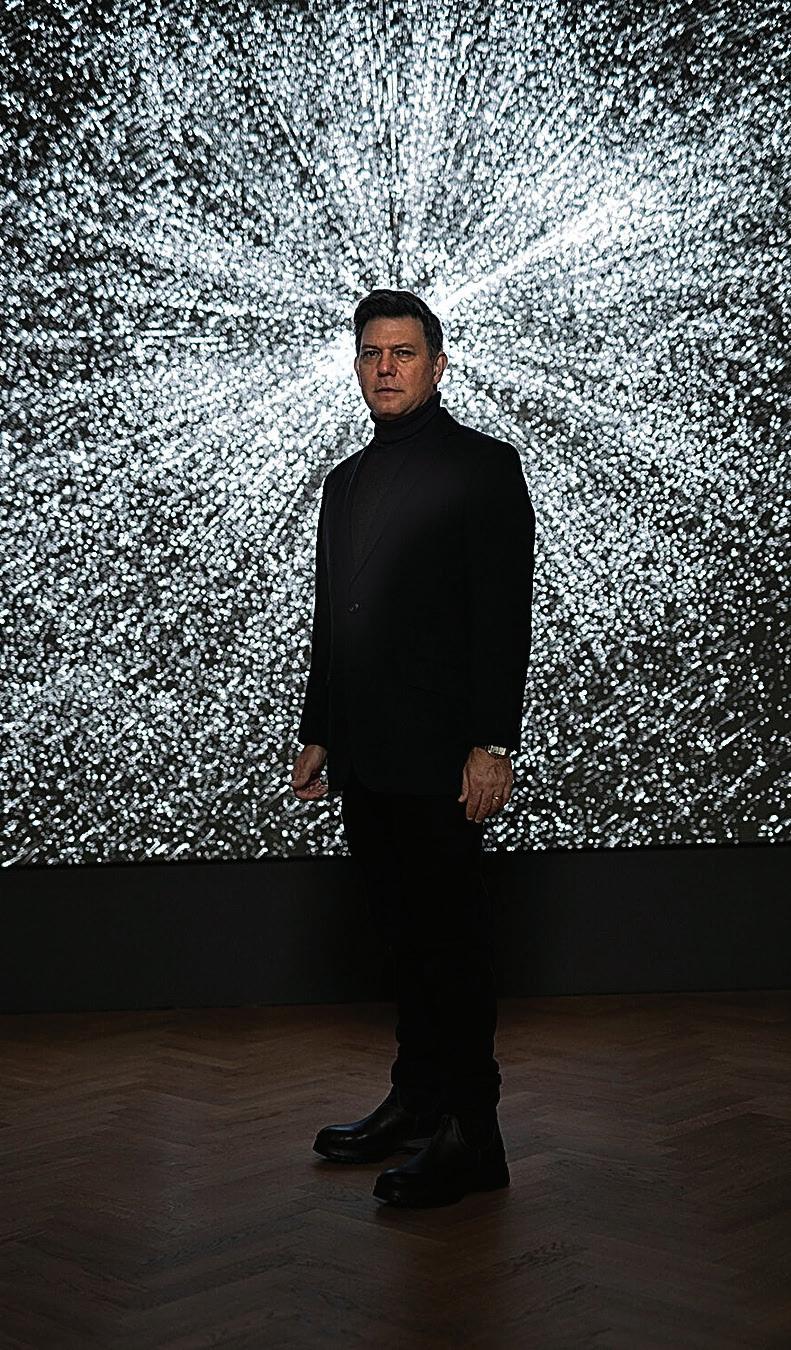
It can produce up to two million colors, Hargrave said. “The technology has come so far that the lights themselves can achieve all these different colors,” she said. “It’s also the programming that Leo has put into play that will help achieve the two million colors.”

Villareal will visit a couple times, and for the main sequencing, he’ll be here about three weeks, observing the environment – including the river and sky, Hargrave said. “So, the sequencing itself is going to be site specific,” she said. “It’s going to be constantly changing, but it will be pre-set.”
Part of the city’s plans with Main Street Landing is to enhance the Skybridge and update lighting to complement what will happen with the Figge. The Skybridge has similarly colored glass panels as the museum.
The $7-million Skybridge also opened in 2005, part of River Renaissance. Iowa taxpayers provided $3.5 million in the form of a Vision Iowa grant, Rhythm City Casino paid $2 million, and the City of Davenport spent $500,000 for its initial construction.
The Figge’s roots began as the Davenport Municipal Art Gallery in 1925, with the passage of a law allowing the city to accept of a gift of 330 artworks from a former mayor, Charles A. Ficke, and open a museum (the first city-owned art museum in Iowa).
It was renamed the Davenport Museum of Art in 1987.
It continued to be a city-run museum until the opening of its new $47-million building in 2005, which was named in honor of a major gift from the V.O. and Elizabeth Kahl Figge Foundation.
At that time, the city transferred responsibility for management, care and exhibition of its collection to the Figge Art Museum, a nonprofit organization.
Ficke’s original collection of European, American and Spanish Viceregal art has grown through the efforts of generations of philanthropists and civic leaders and now includes the Grant Wood Archive and works by other American Regionalist artists, an extensive collection of Haitian art, and contemporary works
It’s important that Villareal’s heritage is Mexican-American, and the Figge supports increasing the profile of artists of color.
“People of color are underrepresented in STEM fields, and this is an opportunity for him to work with students and inspire them to think about this as a possible career,” Hargrave said.
The museum has raised over $120,000 for its Art Diversity and Equity Fund, which is ongoing.
“It’s an important initiative,” she said. “We’re committed to expanding our art collection, to be more representative of our community. We hope people continue to give to that fund.”
The Figge’s art acquisition in the last fiscal year all came from artists of color or underrepresented communities, Hargrave said.
The new fund (launched in 2021) aimed to expand the museum collection of art from Black artists, artists of African, Native American, Hispanic, Latinx, Asian, Pacific Islander, Indigenous and Middle Eastern descent as well as works from women, LGBTQA+, and any other artists who are identified as marginalized, oppressed, or underrepresented in the museum’s permanent collection.
Activated at nightfall, the 2025 lights will brilliantly illuminate the Figge’s landmark glass building, enhancing the riverfront by providing cultural, educational, recreational, and community-building opportunities for residents and increasing tourism to the region.
While it will not be changed to coincide with holidays

(like the I-74 bridge has been lit up in green and red for Christmas), Villareal’s innovative, constantly changing light sculpture will illuminate all four sides of the building.
To see more of Villareal’s architectural commissions, visit his website villareal.net


